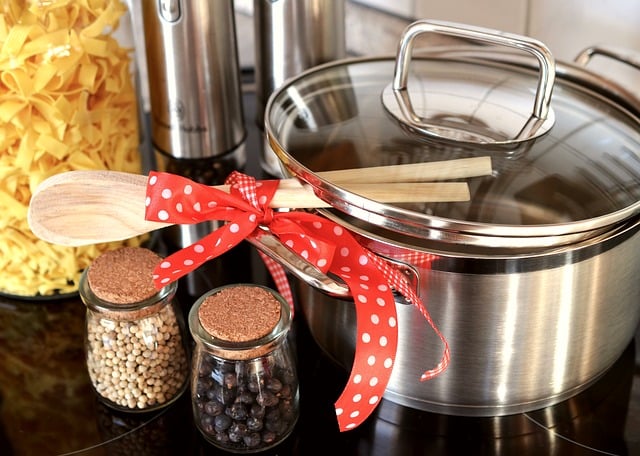
Learning how to cook can be an exciting and rewarding experience for children. It is an excellent way to build a child’s skills and potentially develop an interest in culinary arts. However, the kitchen can also be a dangerous place, especially for children due to the fact that they are not as tall, strong, experienced, or mature as an adult. Because of this, it is necessary for adults to make the kitchen kid-friendly. This can be achieved by establishing and observing safety rules and teaching them to youngsters.
Kitchen Hazards
There are a multitude of dangers that face a child when they come into the kitchen. Kitchen knives and other sharp objects can cause cuts or even result in amputations of fingers. Children also face the risk of potentially disfiguring burns from stove heating elements, scalding liquids, or hot food. In addition, there are a large number of factors that can cause a kitchen fire. Wet floors present the risk of slips and falls, which can also cause burns if a child is holding a pot or plate of hot liquid or food. There is also the danger of potentially deadly food-related illnesses caused by spoilage or improperly handled food.
- Child Safety in the Home: Parent Guide to Child Safety
- Kitchen Hazards and Safety Tips
- 10 Kitchen Dangers and How to Avoid Them
- Hurts and Hazards: Kids, Kitchen Accidents, and Safety (PDF)
- Kitchen 911 Hazards
Reducing Risk
Both parents or guardians and children must work together to make a kitchen more kid-friendly. Children who are cooking should always have adult supervision, especially when they are younger or doing it for the first few times. Sharp objects such as kitchen knives should never be within reach of a child except when they are cutting something under the supervision of an adult.
Because children can grab or bump into pots or pans and cause potentially dangerous spills, it is always necessary to turn all handles inward toward the stove or counter. This includes the handles of pots, pans and skillets. Keep metal objects out of microwave ovens, and never leave the kitchen while something is cooking. Whenever handling any hot objects, everyone in the kitchen should use potholders.
- Burns and Scalds: Prevention Tips
- Kitchen Safety Basics
- 10 Tips to Keep Kids Safe in the Kitchen
- Burn and Scald Prevention: Children Ages One to Four Years
- Child Injury Prevention Alliance: Cooking Safety
Kitchen Rules
Another key to a kid-friendly kitchen is for adults to establish rules for children who are present or who desire to cook or prepare food. It will be necessary to instruct children to never run or play in the kitchen. Ideally, kids should not be allowed in the kitchen while cooking is in progress if they are not participating.
Another important rule is to teach kids to use words like “behind you” to alert others who might back up into them and also look around them to see if it is clear to move. Instruct children under five never to touch any knife in the kitchen, while those older than five may work with butter knives to cut soft objects. Make sure that a child understands never to touch moving mixer beaters or hot stove tops. Finally, adults must lead by example and strictly follow the rules of kitchen safety themselves, as this will instill into children their absolute importance.
- Safety in the Kitchen
- Healthy Children: Kitchen Safety
- Kitchen Safety Rules for Kids
- Being Safe in the Kitchen
- Kitchen Safety
- Set Safety Rules for a Kid-Friendly Kitchen
Kitchen and Food Safety
To prevent illnesses from food-borne microbes and toxins, adults must show children the necessity of handling food safely. Teach children to wash their hands for 20 seconds before touching or preparing food. Clean up spills on the floor and on the counter between stages of food preparation. To prevent cross-contamination, never let raw food and cooked food mix, and do not put cooked food on plates or surfaces where raw food sat.
Wash fruits and vegetables before using them, preferably with a vegetable scrubber, and use hot, soapy water to wash all items and surfaces that have been in contact with food. Always cook raw meats to the proper temperature, which is 145 degrees Fahrenheit for pork, lamb, and beef, 165 degrees for chicken and turkey, and 160 degrees for ground meats. Make sure that the temperature in the refrigerator is kept no higher than 40 degrees Fahrenheit, and never leave food out of the refrigerator or freezer for more than two hours.
- Food Safety Rules Checklist for Children in the Kitchen
- Food Safety After School
- Stay Food Safe With Alvin and the Chipmunks!
- Food Safety Facts
- Food Safety Tips for Kids
- Safe Temperatures for Cooking Meat and Poultry
Additional Resources
- Food Safety for Your Family
- Kitchen Safety for Children on Their Own
- Kitchen Check: Teaching Children How to Cook Safely (PDF)
- Kids Kitchen Safety Checklist (PDF)
- Seven Ways to Keep Kids Safe in the Kitchen
- Keeping Your Children Safe in the Kitchen
- Keeping a Kid-Friendly Kitchen
- Making Your Kitchen Kid-Safe
- Help Prevent Kitchen Fires by Following Safety Tips With Kids
- Kids in the Kitchen
 How Can I Remodel for a Vintage-Style Kitchen?
How Can I Remodel for a Vintage-Style Kitchen?  Corner Bathroom and Kitchen Sinks
Corner Bathroom and Kitchen Sinks  Green Kitchens
Green Kitchens  How to Fix a Leaking Fridge
How to Fix a Leaking Fridge  Ideas to Highlight or Downplay Your Kitchen Cabinets
Ideas to Highlight or Downplay Your Kitchen Cabinets 

Are You Familiar With This Topic? Share Your Experience.